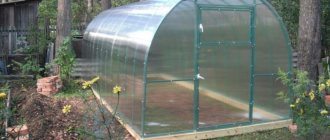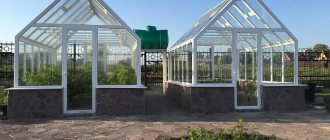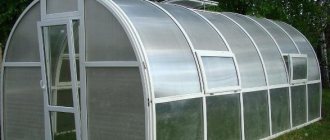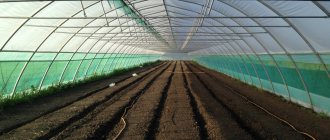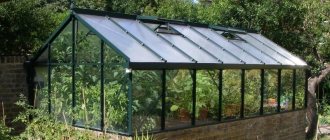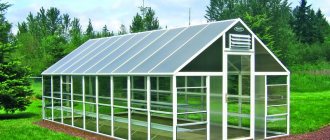Many owners of summer cottages would probably not give up the opportunity to harvest crops all year round. Unfortunately, in most Russian regions the climate is such that this desire looks like a utopia. However, installing a reliable greenhouse equipped with a productive heating system can be a solution to this issue. Recently, gas heating of greenhouses has been considered the most common, which is explained by the appearance on the market of modern equipment - IR emitters and convector heat guns.
Feasibility of heating greenhouses with gas
Previously, due to the lack of a sufficient number of gas heating devices on the markets, the gasification procedure was quite an expensive and troublesome affair. Most often, this approach to heating was used in greenhouses attached to residential buildings.
Did you know? In its natural state, natural gas is tasteless, colorless and odorless. And the familiar specific unpleasant odor of combustible raw materials is acquired by adding (artificially) odorants, which is done to ensure consumer safety.
In this case, it was necessary to connect to a common gas pipeline, for which appropriate permits were required. In addition, we had to look for specialized companies that could perform high-quality installation and “cut” into the common gas pipeline. Given such difficulties, few people have used this approach to heating greenhouses.
Today on the market you can find a lot of different gas appliances that will provide high-quality heating of the room without the need to connect to a common gas supply system. In addition to the fact that gas heating has become more affordable, it has become possible to use it not only in greenhouses attached to houses, but also in buildings located anywhere on the site.
Conclusion
Thus, heating a private greenhouse with a gas gun is not the only scenario when using this type of fuel. A competent approach to the formation of a scheme, taking into account all kinds of factors, attention to modern devices - all this will help to establish a system that will not have any weaknesses. Taking into account the fact that gas in Russia is significantly cheaper than electricity or solid fuel, a well-equipped scheme can pay for itself in just a couple of seasons.
Advantages of gas heating for greenhouses
- The main advantages of gas heating of a greenhouse are:
- high level of efficiency of such equipment - less energy is absorbed than generated;
- the ability to heat a fairly large area;
- no need to search for a place to store fuel, for example, as for diesel and solid fuel boilers;
- When gas is burned in modern installations, the optimal amount of carbon dioxide is released, which is necessary for the normal functioning of plants;
- long service life - from 15 to 50 years, depending on the type of equipment and material used to create it;
- absence of noise during system operation;
- easy maintenance of equipment.
Furnace in operation - start-up and principle of operation
This oven works as follows:
- Used oil is poured
into the container through the filler hole , 2 - 3 l - Light a paper wick and light the fuel
- Cover the hole
with a flap so that there remains a hole with a diameter of 10 - 20 mm - After the fuel ignites, adjust the degree of its combustion
using the damper - After 5 - 6 minutes
the oven will heat up and enter operating mode - regulate the furnace power
using the damper by adding fuel into the filling hole
When adjusting the furnace power, note the time during which your furnace operates on a certain amount of fuel. With the help of simple calculations, you can achieve a result in which you will have to add fuel to the stove tank a minimum number of times.
After all, it is not the fuel itself that burns, but the vapors formed during heating. In this oven you can use:
- Waste oil
- Heavy oil products that cannot be regenerated
Combustion in this furnace occurs in an optimal mode, in which minimal emissions of harmful substances occur into the atmosphere.
- If you go even further and install a water or air jacket on your stove, then this stove can be connected to a water heating system
, the power is quite enough. - As for the greenhouse, heating with this stove will allow you to receive heat practically for nothing
, spending time on delivering used oil.
Agree with the nearest organization or service station, and prepare several barrels on the site for fuel for the heating stove for greenhouses. Your greenhouse will always be provided with free heat, and the service station will be glad to get rid of harmful petroleum products.
Classification of gas heating systems for greenhouses
Gas heating equipment varies in type of design and method of operation.
Depending on this, they are divided into 3 groups:
- infrared;
- catalytic;
- convector.
In addition, there are gas-air and gas-water systems. Not every device is suitable for heating a greenhouse, so you should consider the most appropriate systems to use for such premises.
- Namely:
- heaters with open burners;
- convectors;
- systems operating on gas with infrared burners.
Open burner heaters
Designs of this type consist of a thermostat, as well as two burners - the main one and the pilot one. The devices operate by connecting to a gas cylinder or portable gas heater (you can, for example, use TAG-50).
Did you know? American gas workers easily find leaks in gas systems using carrion vultures. And all thanks to the fact that a reagent with the smell of rotten meat is mixed into the gas itself moving through the system.
The essence of the work is that the heated air rises to the top of the building, and, having cooled somewhat, falls into the plant growing zone, thereby creating optimal microclimatic conditions.
A significant disadvantage of the installation is the combustion of a large amount of oxygen inside the greenhouse, which can negatively affect the condition of the vegetation. To establish proper gas exchange, ventilation must be adjusted. You can get by with a basic exhaust system.
Gas convectors
This type of equipment usually consists of:
- housing - its main function is to protect the room from open fire, so it is made of heat-resistant materials;
- heat exchanger - its main task is to heat the air in a short time, due to the release of its own heat obtained as a result of heating by fire;
- gas burner - consists of an ignition and main part, located inside the heat exchanger;
- combination valve - provides pressure regulation;
- combustion product removal systems;
- thermostat - controls the microclimate by maintaining the set temperature at a constant level;
- automation systems - responsible for analyzing the operation of the entire system as a whole, eliminating emergency situations (turning off the gas supply in the event of a malfunction).
Find out also how to heat a greenhouse with a heating cable.
Regarding combustion product exhaust systems, gas convectors are divided into fireplace and parapet. In the first option, air masses from the room enter the heat exchanger, and combustion products are discharged through a vertical chimney to the street. This exhaust system is typical for a conventional oven.
Parapet convectors are more environmentally friendly in this regard. Air and combustion products are taken in through a coaxial pipe laid through the outer wall. The pressure in the pipe is maintained by a built-in fan.
The essence of the device’s operation is the same as in the previous version, but is carried out using automation. Due to the fact that cold air concentrates in the lower part of the building, as well as near windows and doorways, it is more advisable to install it in close proximity to these areas.
A household heat generator of this type is well suited for installation in a room with a gas supply system. For example, in a greenhouse attached to a house or intended for the production of products on an industrial scale.
Gas heaters with infrared burners
This type of structure was specially developed for heating large areas. At a room temperature of +10°C, by installing it, you can warm up the air to +25°C in a short time within a radius of 6 m from the device.
Important! When purchasing an IR heater for a greenhouse, select models designed for outdoor use, since household appliances are not suitable for residential premises.
This device consists of:
- cylindrical body with a built-in gas cylinder;
- stand with a hose connecting the cylinder to the burner;
- a mesh with a large cross-section and a cylindrical shape, to which the manual control panel is attached;
- hood of a gas burner operating in low pressure mode.
The unit operates using propane. For 15 hours of continuous operation, a cylinder weighing 11.5 kg is sufficient. The burner is triggered by piezo ignition. The latest devices have automated panels that regulate the microclimate independently.
The main difference between infrared heaters and convectors is that they heat not the volume of air, but objects located within a radius of 6 m from them. When installing such a system, you need to ensure that there is an exhaust system in the greenhouse to remove combustion products.
Basic Rules
In greenhouses with a large area, it is necessary to connect to a common gas pipeline network; small greenhouses can be heated with gas cylinders.
To heat a room with gas, you can use various heating equipment: gas burners or air heaters. Each of them has its own characteristics. Using burners is more dangerous. However, provided that there are no wooden elements in the greenhouse structure, you can resort to burners. In this case, the burners simply need to be connected to cylinders and placed throughout the entire area of the room requiring heating. Installing a heating system requires a lot of expense and effort, but this option will prove to be more convenient to use in the future.
Particular attention must be paid to the uniform distribution of heat in the room, as this represents the greatest difficulty when organizing gas heating. To do this, you need to connect a sufficient number of burners to the gas cylinder, which will be distributed evenly throughout the room. At the same time, providing gas heating to a greenhouse requires compliance with certain safety measures. For example, access to gas burners should not be hampered in any way. If any problems occur in their operation, it should be possible to turn them off immediately. In addition, gas equipment requires constant preventive maintenance.
Heating using gas requires an efficient ventilation system. A hood may need to be installed. This is due to the fact that gas heating leads to a lack of oxygen over time.
The advantage of air heaters is that they are able to provide a sufficient amount of heat and at the same time mix the heated air. Their only drawback is their high cost. First of all, costs will be required for the installation of polyethylene perforated pipes, which should form an entire system. In addition, it is necessary to install a chimney that will ensure the removal of combustion products from the room.
How to pipe gas into a greenhouse with your own hands?
If you plan to connect to a common gas pipeline, you cannot deal with this issue yourself. First of all, you should contact the relevant organizations to obtain permission and draw up a plan. After this, you need to invite a professional gas fitter who will carry out the work according to the established instructions and issue the relevant documents.
For self-installation of gas heating in a small, free-standing greenhouse, it is best to use the option with infrared burners. It is easier to install. To begin with, you need to decide on the installation location. The market offers models designed for ceiling, parapet, wall mounting and mobile.
Then you should start organizing the ventilation system. It can be made from PVC pipes with a cross-section of 10 cm. At one end of the building, the pipe is fixed so that it rises 50 cm above the roof level.
Important! For unauthorized connection to a common gas pipeline, without special approval documents, criminal liability is provided. In addition, all manipulations must be carried out by government organizations.
On the opposite side, the pipe is mounted so that its lower end is located at a level of 1 m from the soil, and extends 10 cm beyond the roof level. Thus, one pipe will serve to supply air, the other will serve to remove it from the room.
Next, the devices themselves are installed. Basic requirements for their installation:
- There must be at least 1 m from the soil level to the equipment.
- A distance of at least 1 m must also be maintained to the plantings and from the heater.
- If you need to place several IR devices, then they are installed at a distance of 0.5 m from each other.
When connecting equipment to gas cylinders, all actions are quite simple. A hose is connected to the reducer on the cylinder and secured to the equipment. All fixation points are reinforced with clamps.
Video: Installing infrared heaters in a greenhouse
Some features
When heating a greenhouse with gas, oxygen burns out and burns out, which is dangerous for plants, so ventilation/air supply systems must also operate simultaneously with gas heating.
Heating a greenhouse with gas means turning to specialists for help. Do not neglect this, as gas is a flammable and explosive substance. Failure to take the necessary safety precautions can pose a threat to your health and even your life. If you contact a specialist in this matter, he will help you determine the optimal number of burners or heaters that will provide heating for a greenhouse of a certain size for growing certain crops.
So, the undeniable advantages that heating a greenhouse with gas have:
- efficiency;
- efficiency;
- safety (subject to professional installation by a specialist in this field, who will give recommendations on the safe operation of heating devices).
Thus, you know the basic principles of arranging a heating system using gas. Compared to other methods of heating a room for growing plants, the use of gas has significant advantages. Most gardeners prefer it. However, the heat obtained in this way may not be enough if you need to heat a large greenhouse throughout the year.
In order for the plants in the greenhouse to bear fruit all year round, it needs to be equipped with a heating system. One such method is gasification. How feasible is this approach to heating a greenhouse space and how the system itself can be designed, read below.
Safety precautions when connecting gas
If it was decided to use gas cylinders for heating the greenhouse, safety precautions must be observed when connecting them to devices:
- After connecting the cylinder through the reducer to the equipment and securing the clamps, check for leaks. To do this, cover all connections with soap foam (any kind will do). If the formation of bubbles is observed, then there is a leak, and therefore it is necessary to tighten all connections again and carry out the control act again.
- Place the gas cylinder 1 m away from the heating device.
- Do not check the tightness of connections using burning paper or similar tricks.
- When filling a cylinder, the volume of gas in the container should not exceed 85% of the total in order to avoid an increase in internal pressure.
Gas heating in greenhouses today is an affordable and economical heating option, allowing you to obtain crops all year round. The main thing is to choose the right equipment and observe safety measures during its subsequent operation.
Recycling plus heating
Stoves for heating greenhouses can use other types of fuel. For example, if you use a furnace that runs on used motor oil
, then you are unlikely to have a problem purchasing this type of fuel.
Many enterprises and service stations will be happy to get rid of working hours. Let's look at a waste oil furnace. Of course, it is more difficult to manufacture
, but everything will be more than justified when using it. Homemade stoves for greenhouses using this type of fuel never lack it in areas with a wide network of service stations and enterprises using trucks.
The figure shows a diagram of this furnace. becomes red hot during operation.
. You can successfully cook food on it.
We provide precise drawings describing the materials for the manufacture of this furnace. You can use a stainless steel chimney pipe.
Chimney – vertical only
Let’s make a reservation right away that this stove does not involve the use of horizontal sections of the chimney. In other words, we choose a chimney for this stove that is strictly vertical.
